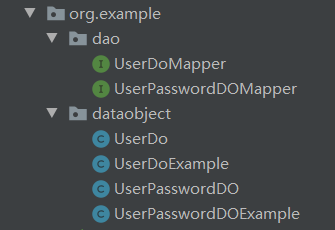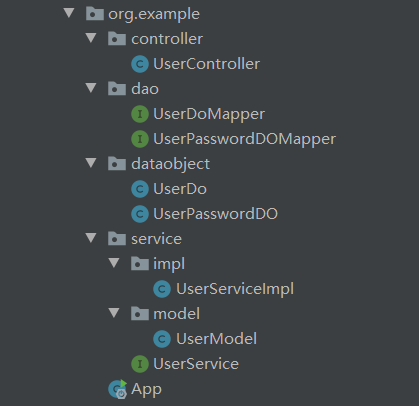一、项目功能概述
电商秒杀需要完成的3个功能:
1.展示一个商品列表页面,我们可以从中看到可秒杀的商品列表
2.点击进入商品详情页,获取该商品的详细信息
3.秒杀时间开始后,点击进入下单确认页面,并支付成功
二、基于SpringBoot进行项目环境搭建
步骤1:创建一个maven工程,使用quickStart骨架。
步骤2:在pom.xml导入SpringBoot相关依赖。
<?xml version="1.0" encoding="UTF-8"?>
<project xmlns="http://maven.apache.org/POM/4.0.0" xmlns:xsi="http://www.w3.org/2001/XMLSchema-instance"
xsi:schemaLocation="http://maven.apache.org/POM/4.0.0 http://maven.apache.org/xsd/maven-4.0.0.xsd">
<modelVersion>4.0.0</modelVersion>
<groupId>org.example</groupId>
<artifactId>Spike</artifactId>
<version>1.0-SNAPSHOT</version>
<name>Spike</name>
<!-- FIXME change it to the project's website -->
<url>http://www.example.com</url>
<parent>
<groupId>org.springframework.boot</groupId>
<artifactId>spring-boot-starter-parent</artifactId>
<version>2.0.5.RELEASE</version>
</parent>
<properties>
<project.build.sourceEncoding>UTF-8</project.build.sourceEncoding>
<maven.compiler.source>1.8</maven.compiler.source> <maven.compiler.target>1.8</maven.compiler.target>
</properties>
<dependencies>
<dependency>
<groupId>org.springframework.boot</groupId>
<artifactId>spring-boot-starter-web</artifactId>
</dependency>
<dependency>
<groupId>junit</groupId>
<artifactId>junit</artifactId>
<version>4.11</version>
<scope>test</scope>
</dependency>
</dependencies>
<build>
<pluginManagement><!-- lock down plugins versions to avoid using Maven defaults (may be moved to parent pom) -->
<plugins>
<!-- clean lifecycle, see https://maven.apache.org/ref/current/maven-core/lifecycles.html#clean_Lifecycle -->
<plugin>
<artifactId>maven-clean-plugin</artifactId>
<version>3.1.0</version>
</plugin>
<!-- default lifecycle, jar packaging: see https://maven.apache.org/ref/current/maven-core/default-bindings.html#Plugin_bindings_for_jar_packaging -->
<plugin>
<artifactId>maven-resources-plugin</artifactId>
<version>3.0.2</version>
</plugin>
<plugin>
<artifactId>maven-compiler-plugin</artifactId>
<version>3.8.0</version>
</plugin>
<plugin>
<artifactId>maven-surefire-plugin</artifactId>
<version>2.22.1</version>
</plugin>
<plugin>
<artifactId>maven-jar-plugin</artifactId>
<version>3.0.2</version>
</plugin>
<plugin>
<artifactId>maven-install-plugin</artifactId>
<version>2.5.2</version>
</plugin>
<plugin>
<artifactId>maven-deploy-plugin</artifactId>
<version>2.8.2</version>
</plugin>
<!-- site lifecycle, see https://maven.apache.org/ref/current/maven-core/lifecycles.html#site_Lifecycle -->
<plugin>
<artifactId>maven-site-plugin</artifactId>
<version>3.7.1</version>
</plugin>
<plugin>
<artifactId>maven-project-info-reports-plugin</artifactId>
<version>3.0.0</version>
</plugin>
</plugins>
</pluginManagement>
</build>
</project>
步骤3:在main/java/app中,我们对SpringBoot和SpringMVC进行简单的配置工作。掌握这几个注解的作用。
package org.example;
import org.springframework.boot.SpringApplication;
import org.springframework.boot.autoconfigure.EnableAutoConfiguration;
import org.springframework.web.bind.annotation.RequestMapping;
import org.springframework.web.bind.annotation.RestController;
//SpringBoot会帮我们启动tomcat,并加载默认配置
@EnableAutoConfiguration
//SpringMVC相关配置
@RestController
public class App {
@RequestMapping("/")
public String home(){
//网页中输出
return "Hello World!";
}
public static void main( String[] args ){
//控制台输出
System.out.println( "Hello World!" );
SpringApplication.run(App.class,args);
}
}
运行结果:
用浏览器打开http://localhost:8080/,我们可以看到页面上输出:Hello World!
同时,控制台也输出了Hello World!,以及一些Spring相关的信息。
SpringBoot小技巧:可以在resource目录下创建一个application.propeties配置文件,在其中写:server.port = 端口号来设置端口号。
步骤4:接入mybatis,首先在pom.xml添加需要的依赖(mysql,druid连接池,mybatis)
写一个plugin标签,引入对应的mybatis自动生成文件的插件 {
添加对应的依赖:mybatis generator的core(第一次使用要单独在前面导入依赖,不可直接放在plugin中),mysql数据库的解析
写一个excution标签:设置允许移动生成的文件,允许自动覆盖文件(实际工作中不可以)
写一个configuration标签:指定mybatis generator 配置文件的路径 }
1 <?xml version="1.0" encoding="UTF-8"?> 2 3 <project xmlns="http://maven.apache.org/POM/4.0.0" xmlns:xsi="http://www.w3.org/2001/XMLSchema-instance" 4 xsi:schemaLocation="http://maven.apache.org/POM/4.0.0 http://maven.apache.org/xsd/maven-4.0.0.xsd"> 5 <modelVersion>4.0.0</modelVersion> 6 7 <groupId>org.example</groupId> 8 <artifactId>Spike</artifactId> 9 <version>1.0-SNAPSHOT</version> 10 11 <name>Spike</name> 12 <!-- FIXME change it to the project's website --> 13 <url>http://www.example.com</url> 14 15 <parent> 16 <groupId>org.springframework.boot</groupId> 17 <artifactId>spring-boot-starter-parent</artifactId> 18 <version>2.0.5.RELEASE</version> 19 </parent> 20 21 <properties> 22 <project.build.sourceEncoding>UTF-8</project.build.sourceEncoding> 23 <maven.compiler.source>1.8</maven.compiler.source> 24 <maven.compiler.target>1.8</maven.compiler.target> 25 </properties> 26 27 <dependencies> 28 <dependency> 29 <groupId>org.springframework.boot</groupId> 30 <artifactId>spring-boot-starter-web</artifactId> 31 </dependency> 32 <dependency> 33 <groupId>mysql</groupId> 34 <artifactId>mysql-connector-java</artifactId> 35 <version>5.1.6</version> 36 </dependency> 37 <dependency> 38 <groupId>com.alibaba</groupId> 39 <artifactId>druid</artifactId> 40 <version>1.1.3</version> 41 </dependency> 42 <dependency> 43 <groupId>org.mybatis.spring.boot</groupId> 44 <artifactId>mybatis-spring-boot-starter</artifactId> 45 <version>1.3.1</version> 46 </dependency> 47 <dependency> 48 <groupId>junit</groupId> 49 <artifactId>junit</artifactId> 50 <version>4.11</version> 51 <scope>test</scope> 52 </dependency> 53 <dependency> 54 <groupId>org.mybatis.generator</groupId> 55 <artifactId>mybatis-generator-core</artifactId> 56 <version>1.3.5</version> 57 </dependency> 58 </dependencies> 59 60 <build> 61 <pluginManagement><!-- lock down plugins versions to avoid using Maven defaults (may be moved to parent pom) --> 62 <plugins> 63 <!-- clean lifecycle, see https://maven.apache.org/ref/current/maven-core/lifecycles.html#clean_Lifecycle --> 64 <plugin> 65 <artifactId>maven-clean-plugin</artifactId> 66 <version>3.1.0</version> 67 </plugin> 68 <!-- default lifecycle, jar packaging: see https://maven.apache.org/ref/current/maven-core/default-bindings.html#Plugin_bindings_for_jar_packaging --> 69 <plugin> 70 <artifactId>maven-resources-plugin</artifactId> 71 <version>3.0.2</version> 72 </plugin> 73 <plugin> 74 <artifactId>maven-compiler-plugin</artifactId> 75 <version>3.8.0</version> 76 </plugin> 77 <plugin> 78 <artifactId>maven-surefire-plugin</artifactId> 79 <version>2.22.1</version> 80 </plugin> 81 <plugin> 82 <artifactId>maven-jar-plugin</artifactId> 83 <version>3.0.2</version> 84 </plugin> 85 <plugin> 86 <artifactId>maven-install-plugin</artifactId> 87 <version>2.5.2</version> 88 </plugin> 89 <plugin> 90 <artifactId>maven-deploy-plugin</artifactId> 91 <version>2.8.2</version> 92 </plugin> 93 94 <!-- site lifecycle, see https://maven.apache.org/ref/current/maven-core/lifecycles.html#site_Lifecycle --> 95 <plugin> 96 <artifactId>maven-site-plugin</artifactId> 97 <version>3.7.1</version> 98 </plugin> 99 <plugin> 100 <artifactId>maven-project-info-reports-plugin</artifactId> 101 <version>3.0.0</version> 102 </plugin> 103 104 <plugin> 105 <groupId>org.mybatis.generator</groupId> 106 <artifactId>mybatis-generator-maven-plugin</artifactId> 107 <version>1.3.5</version> 108 <dependencies> 109 <dependency> 110 <groupId>org.mybatis.generator</groupId> 111 <artifactId>mybatis-generator-core</artifactId> 112 <version>1.3.5</version> 113 </dependency> 114 <dependency> 115 <groupId>mysql</groupId> 116 <artifactId>mysql-connector-java</artifactId> 117 <version>5.1.6</version> 118 </dependency> 119 </dependencies> 120 <executions> 121 <execution> 122 <id>mybatis generator</id> 123 <phase>package</phase> 124 <goals> 125 <goal>generate</goal> 126 </goals> 127 </execution> 128 </executions> 129 <configuration> 130 <!--允许移动生成的文件--> 131 <verbose>true</verbose> 132 <!--允许自动覆盖文件--> 133 <overwrite>true</overwrite> 134 <!--mybatis generator 配置文件的路径--> 135 <configurationFile> 136 src/main/resource/mybatis-generator.xml 137 </configurationFile> 138 </configuration> 139 </plugin> 140 141 </plugins> 142 </pluginManagement> 143 </build> 144 </project>
步骤5:创建mysql底层的数据库与相关表格
1.创建数据库spike
2.创建一个user_info表格

3.创建一个user_password表格,并设置user_id为外键关联user_info的id

步骤6:在步骤4中,我们最后指定了mybatis generator 配置文件的路径,于是我们在指定路径(resource目录下)创建一个mybatis generator.xml,并进行如下配置:
<?xml version="1.0" encoding="UTF-8"?>
<!DOCTYPE generatorConfiguration
PUBLIC "-//mybatis.org//DTD MyBatis Generator Configuration 1.0//EN"
"http://mybatis.org/dtd/mybatis-generator-config_1_0.dtd">
<generatorConfiguration>
<context id="mysql" targetRuntime="MyBatis3" >
<!--数据库连接地址账号密码-->
<jdbcConnection driverClass="com.mysql.jdbc.Driver" connectionURL="jdbc:mysql://127.0.0.1:3306/spike" userId="root" password="0322">
</jdbcConnection>
<!--生成Data Object类存放位置-->
<javaModelGenerator targetPackage="org.example.dataobject" targetProject="src/main/java">
<property name="enableSubPackages" value="true"/>
<property name="trimStrings" value="true"/>
</javaModelGenerator>
<!--生成映射文件存放位置-->
<sqlMapGenerator targetPackage="mapping" targetProject="src/main/resources">
<property name="enableSubPackages" value="true"/>
</sqlMapGenerator>
<!--生成dao类存放位置-->
<javaClientGenerator targetPackage="org.example.dao" type="XMLMAPPER" targetProject="src/main/java">
<property name="enableSubPackages" value="true"/>
</javaClientGenerator>
<!--生成对应表及类名-->
<table tableName="user_info" domainObjectName="UserDo" enableCountByExample="false"
enableUpdateByExample="false" enableDeleteByExample="false"
enableSelectByExample="false" selectByExampleQueryId="false"
></table>
<table tableName="user_password" domainObjectName="UserPasswordDO" enableCountByExample="false"
enableUpdateByExample="false" enableDeleteByExample="false"
enableSelectByExample="false" selectByExampleQueryId="false"
></table>
</context>
</generatorConfiguration>
步骤7:根据步骤6中指定的位置,我们在org.example目录下新建一个dataobject的包,一个dao包。并测试是否能够成功生成相应的文件:
run——edit configurations——+maven——command line:mybatis-generator:generate——apply
然后我们运行这个新建的命令,可以看到resources/mapping下多了两个文件:

dataobject包与dao包下生成了如下文件:

手动删除两个Example文件。
步骤8:为了接入mybatis对应mysql的数据源,我们继续编写application.properties文件
server.port = 8090 mybatis.mapperLocations = classpath:mapping/*.xml spring.datasource.name = Spike spring.datasource.url = jdbc:mysql://127.0.0.1:3306/Spike spring.datasource.username = root spring.datasource.password = 0322 #使用druid数据源 spring.datasource.type = com.alibaba.druid.pool.DruidDataSource spring.datasource.driverClassName = com.mysql.jdbc.Driver
步骤9:回到app.java
将@EnableAutoConfiguration注解改为@SpringBootApplication(scanBasePackages = "org.example"),作用是将app交给spring托管,并且指定为主启动类。
添加注解@MapperScan("org.example.dao"),把dao存放的地方设置在对应注解下面。
最后,写一个方法来测试我们的搭建工作是否完成,(事先在表格中添加一条数据)
package org.example;
import org.example.dao.UserDoMapper;
import org.example.dataobject.UserDo;
import org.mybatis.spring.annotation.MapperScan;
import org.springframework.beans.factory.annotation.Autowired;
import org.springframework.boot.SpringApplication;
import org.springframework.boot.autoconfigure.SpringBootApplication;
import org.springframework.web.bind.annotation.RequestMapping;
import org.springframework.web.bind.annotation.RestController;
//SpringBoot会帮我们启动tomcat,并加载默认配置
@SpringBootApplication(scanBasePackages = {"org.example"})
//SpringMVC相关配置
@RestController
@MapperScan("org.example.dao")
public class App {
@Autowired
private UserDoMapper userDoMapper;
@RequestMapping("/")
public String home(){
UserDo userDo = userDoMapper.selectByPrimaryKey(1);
if(userDo == null){
return "用户对象不存在";
}else{
return userDo.getName();
}
}
public static void main( String[] args ){
//控制台输出
System.out.println( "Hello World!" );
SpringApplication.run(App.class,args);
}
}
app.java
打开http://localhost:8090/,我们可以看到页面上显示了我们添加的数据中name字段的内容。
三、用户模块开发
1.使用SpingMVC模式开发用户信息
步骤1:补全框架结构:

步骤2:service层的编写:
UserService接口:
package org.example.service;
import org.example.service.model.UserModel;
public interface UserService {
UserModel getUserById(Integer id);
}
UserService实现类:
@Service
public class UserServiceImpl implements UserService {
@Autowired
private UserDoMapper userDoMapper;
@Autowired
private UserPasswordDOMapper userPasswordDOMapper;
@Override
public UserModel getUserById(Integer id) {
UserDo userDo = userDoMapper.selectByPrimaryKey(id);
if(userDo == null){
return null;
}
//通过用户id获取对应的用户加密密码信息
UserPasswordDO userPasswordDO = userPasswordDOMapper.selectByUserId(userDo.getId());
return convertFromDataObject(userDo,userPasswordDO);
}
public UserModel convertFromDataObject(UserDo userDo, UserPasswordDO userPasswordDO) {
if(userDo == null){
return null;
}
UserModel userModel = new UserModel();
BeanUtils.copyProperties(userDo,userModel);
if(userPasswordDO != null){
userModel.setEncriptPassword(userPasswordDO.getEncriptPassword());
}
return userModel;
}
}
UserModel类:存放数据库的所有对应字段与getters&setters,用于service层与数据库数据的解耦,使service层无法直接接触数据库
1 package org.example.service.model;
2
3 public class UserModel {
4 private Integer id;
5 private String name;
6 private Byte gender;
7 private Integer age;
8 private String telephone;
9 private String registerMode;
10 private String thirdPartyId;
11 private String encriptPassword;
12
13 public Integer getId() {
14 return id;
15 }
16
17 public void setId(Integer id) {
18 this.id = id;
19 }
20
21 public String getName() {
22 return name;
23 }
24
25 public void setName(String name) {
26 this.name = name;
27 }
28
29 public Byte getGender() {
30 return gender;
31 }
32
33 public void setGender(Byte gender) {
34 this.gender = gender;
35 }
36
37 public Integer getAge() {
38 return age;
39 }
40
41 public void setAge(Integer age) {
42 this.age = age;
43 }
44
45 public String getTelephone() {
46 return telephone;
47 }
48
49 public void setTelephone(String telephone) {
50 this.telephone = telephone;
51 }
52
53 public String getRegisterMode() {
54 return registerMode;
55 }
56
57 public void setRegisterMode(String registerMode) {
58 this.registerMode = registerMode;
59 }
60
61 public String getThirdPartyId() {
62 return thirdPartyId;
63 }
64
65 public void setThirdPartyId(String thirdPartyId) {
66 this.thirdPartyId = thirdPartyId;
67 }
68
69 public String getEncriptPassword() {
70 return encriptPassword;
71 }
72
73 public void setEncriptPassword(String encriptPassword) {
74 this.encriptPassword = encriptPassword;
75 }
76 }
步骤3:修改UserPasswordDOMapper.xml,添加一个selectByUserId操作的配置
<select id="selectByUserId" parameterType="java.lang.Integer" resultMap="BaseResultMap">
select
<include refid="Base_Column_List" />
from user_password
where user_id = #{userId,jdbcType=INTEGER}
</select>
同步修改UserPasswordDOMapper.java,添加一行代码:
UserPasswordDO selectByUserId(Integer userId);
步骤4:编写Controller包中的UserController.java
@Controller("user")
@RequestMapping("/user")
public class UserController {
@Autowired
private UserService userService;
@RequestMapping("/get")
@ResponseBody
public UserModel getUser(@RequestParam(name="id") Integer id) {
//调用service服务获取对应id的用户对象并返回给前端
UserModel userModel = userService.getUserById(id);
return userModel;
}
}
运行后,访问http://localhost:8090/user/get?id=1(需要事先添加好一条完整的数据),可以看到页面上输出了这条数据的完整信息。
步骤5:发现问题:在UserController中,我们把userModel模型直接返回给前端,导致密码直接输出在页面中,这是非常不专业的。
因此,我们在controller层(包)中需要新建一个模型对象。在controller层中新建一个viewobject包,并在其中写一个viewobject类,里面只写需要展示在前端的字段与getters&setters。
1 package org.example.controller.viewobject;
2
3 public class UserVO {
4 //只写前端用户所需要的信息
5 private Integer id;
6 private String name;
7 private Byte gender;
8 private Integer age;
9 private String telephone;
10
11 public Integer getId() {
12 return id;
13 }
14
15 public void setId(Integer id) {
16 this.id = id;
17 }
18
19 public String getName() {
20 return name;
21 }
22
23 public void setName(String name) {
24 this.name = name;
25 }
26
27 public Byte getGender() {
28 return gender;
29 }
30
31 public void setGender(Byte gender) {
32 this.gender = gender;
33 }
34
35 public Integer getAge() {
36 return age;
37 }
38
39 public void setAge(Integer age) {
40 this.age = age;
41 }
42
43 public String getTelephone() {
44 return telephone;
45 }
46
47 public void setTelephone(String telephone) {
48 this.telephone = telephone;
49 }
50 }
同时,我们修改UserController类,将UserModel转化为viewobject后,再返回给前端。
@Controller("user")
@RequestMapping("/user")
public class UserController {
@Autowired
private UserService userService;
@RequestMapping("/get")
@ResponseBody
public UserVO getUser(@RequestParam(name="id") Integer id) {
//调用service服务获取对应id的用户对象并返回给前端
UserModel userModel = userService.getUserById(id);
//将核心领域模型对象转化为可供UI使用的viewobject
return convertFromModel(userModel);
}
private UserVO convertFromModel(UserModel userModel){
if(userModel == null){
return null;
}
UserVO userVO = new UserVO();
BeanUtils.copyProperties(userModel,userVO);
return userVO;
}
}
这一步中,我们做了一个完整的从数据库中读取数据,展示在前端页面上的操作。
controller层——>service层——>dao层
dataobject层负责数据存储到service的传输,并且在用户的service的服务中组装了对应的核心领域模型。
controller层做了到用户viewobject之间的传递,保证密码等信息不会输出到前端。
2.定义通用的返回对象
步骤1:自主管理前端页面的返回——返回正确信息
org.example包下创建一个response包,在其中创建一个CommonReturnType.java文件。
在该文件中,设置两个属性:status,data,并生成对应的getters&setters。然后写两个构造方法,包含了两个属性的设置。
package org.example.response;
public class CommonReturnType {
//表名对应请求的返回处理结果,success/fail
private String status;
//若status返回success,则data内返回前端需要的json数据
//若status返回success,则data内使用通用的错误码格式
private Object data;
//定义一个通用的创建方法
public static CommonReturnType create(Object result){
return CommonReturnType.create(result,"success");
}
public static CommonReturnType create(Object result,String status){
CommonReturnType type = new CommonReturnType();
type.setStatus(status);
type.setData(result);
return type;
}
public String getStatus() {
return status;
}
public void setStatus(String status) {
this.status = status;
}
public Object getData() {
return data;
}
public void setData(Object data) {
this.data = data;
}
}
修改我们的UserController.java,将返回值改为CommonReturnType,由CommonReturnType调用create方法来引用UserVO中的信息。以下代码为需要修改的部分:
public CommonReturnType getUser(@RequestParam(name="id") Integer id) {
//调用service服务获取对应id的用户对象并返回给前端
UserModel userModel = userService.getUserById(id);
//将核心领域模型对象转化为可供UI使用的viewobject
UserVO userVO = convertFromModel(userModel);
//返回通用对象
return CommonReturnType.create(userVO);
}
运行后,我们仍然访问http://localhost:8090/user/get?id=1,可以看到页面上输出了:

步骤2:自主管理前端页面的返回——返回错误信息
org.example包下创建一个error包,在其中创建一个CommonError接口,写3个方法:获取错误码,获取错误信息,设置错误信息
public interface CommonError {
public int getErrCode();
public String getErrMsg();
public CommonError setErrMsg(String errMsg);
}
error包下写一个枚举类型的EmBusinessError,实现CommonError接口。
package org.example.error;
public enum EmBusinessError implements CommonError{
//通用错误类型10001
PARAMETER_VALIDATION_ERROR(10001,"参数不合法"),
//未知错误10002
UNKNOWN_ERROR(10002,"未知错误"),
//20000开头相关为用户信息相关错误定义
USER_NOT_EXIST(20001,"用户不存在"),
;
private EmBusinessError(int errCode,String errMsg){
this.errCode = errCode;
this.errMsg = errMsg;
}
private int errCode;
private String errMsg;
@Override
public int getErrCode() {
return this.errCode;
}
@Override
public String getErrMsg() {
return this.errMsg;
}
@Override
public CommonError setErrMsg(String errMsg) {
this.errMsg = errMsg;
return this;
}
}
error包下写一个BusinessException,实现CommonError接口,并继承Exception类。
public class BusinessException extends Exception implements CommonError{
private CommonError commonError;
//直接接收EmBusinessError的传参用于构造业务异常
public BusinessException(CommonError commonError) {
super();
this.commonError = commonError;
}
public BusinessException(CommonError commonError,String errMsg) {
super();
this.commonError = commonError;
this.commonError.setErrMsg(errMsg);
}
@Override
public int getErrCode() {
return this.commonError.getErrCode();
}
@Override
public String getErrMsg() {
return this.commonError.getErrMsg();
}
@Override
public CommonError setErrMsg(String errMsg) {
this.commonError.setErrMsg(errMsg);
return this;
}
}
UserController中添加如下代码:
//若获取的对应用户信息不存在
if(userModel==null){
throw new BusinessException(EmBusinessError.USER_NOT_EXIST);
}
步骤3:异常处理
在controller目录下单独写一个BaseController类,定义exceptionhandler解决未被controller层吸收的exception。
import java.util.Map;
public class BaseController {
//定义exceptionhandler解决未被controller层吸收的exception
@ExceptionHandler(Exception.class)
@ResponseStatus(HttpStatus.OK)
@ResponseBody
public Object handlerException(HttpServletRequest request, Exception ex){
Map<String,Object> responseData = new HashMap<>();
if(ex instanceof BusinessException){
BusinessException businessException = (BusinessException)ex;
responseData.put("errCode",businessException.getErrCode());
responseData.put("errMsg",businessException.getErrMsg());
}else{
responseData.put("errCode", EmBusinessError.UNKNOWN_ERROR.getErrCode());
responseData.put("errMsg",EmBusinessError.UNKNOWN_ERROR.getErrMsg());
}
return CommonReturnType.create(responseData,"fail");
}
}
然后,UserController类需要继承BaseController类。
运行后,我们访问http://localhost:8090/user/get?id=2,(id=2的数据是不存在的),可以看到页面为:

为了程序的健壮性,我们在BaseController中添加了一个unknown error。我们可以手动地来测试一下这段代码是否起了作用:
修改UserController部分代码如下:
if(userModel==null){
userModel.setEncriptPassword("123");
//throw new BusinessException(EmBusinessError.USER_NOT_EXIST);
}
运行后,我们再次访问http://localhost:8090/user/get?id=2,可以看到页面为:

以上就是本文的全部内容,希望对大家的学习有所帮助,也希望大家多多支持自学编程网。

- 本文固定链接: https://zxbcw.cn/post/187413/
- 转载请注明:必须在正文中标注并保留原文链接
- QQ群: PHP高手阵营官方总群(344148542)
- QQ群: Yii2.0开发(304864863)
